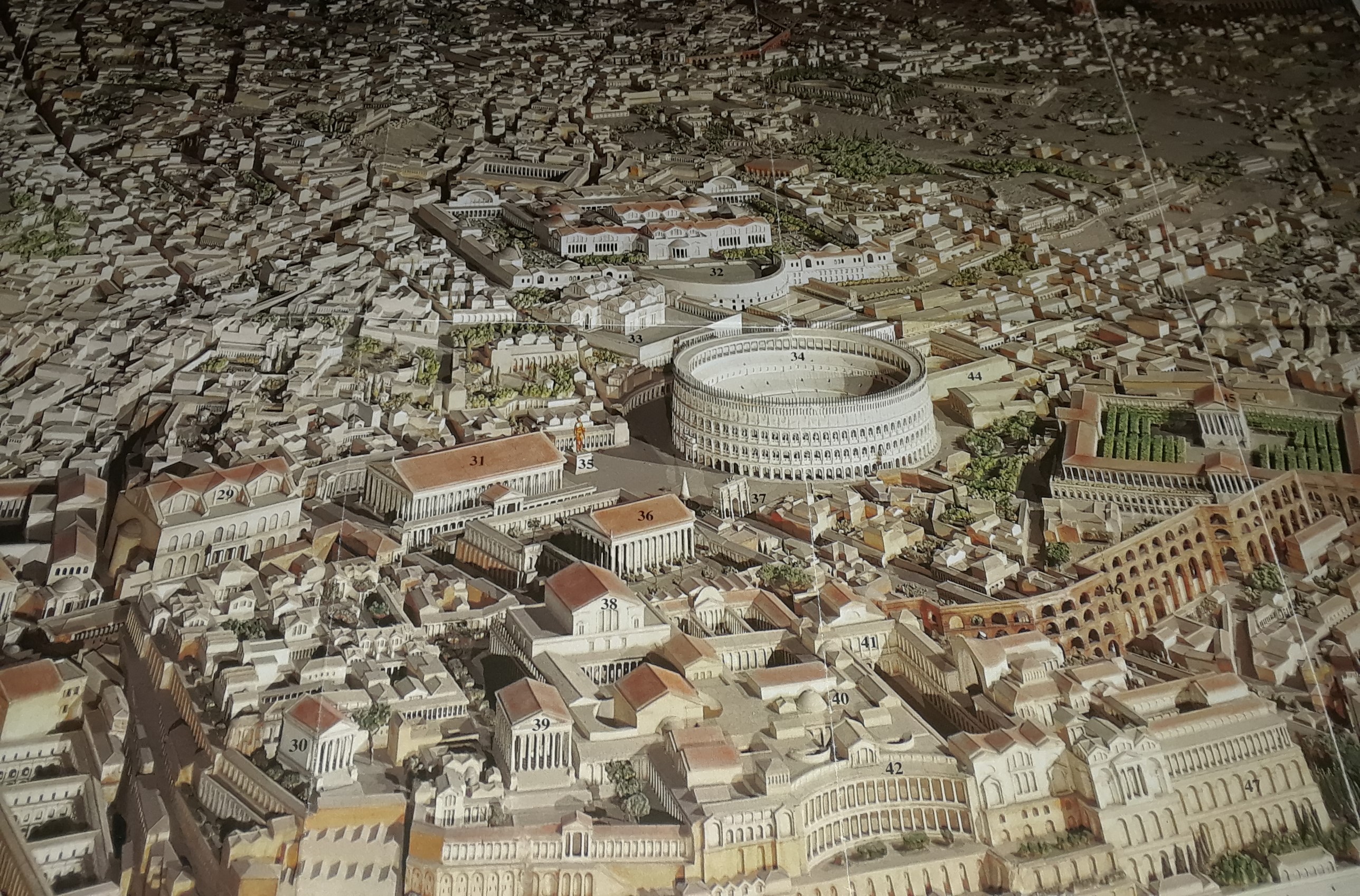

Photos of a scale model of ancient Rome in the age of Constantine I by Italo Gismondi
This website contains a collection of photographs of Rome, Italy. Phillip W. Weiss is the author of the photographs, He took these photographs between January 2 and January 12, 2018. The photograph are grouped under broad general headings, each one assigned a page. Only one pic has a caption. The pics are meant to speak for themselves.
The photographs vary in quality. That is due primarily to the camera, which did not operate well in low light. This accounts for the blur in many of the pics taken indoor or during the evening or at night.
The ancient Roman ruins are impressive. They are the relics left by a people who have long since departed. Most of these relics were built by slaves, Their identities are unknown. Where the Romans conquered they plundered. They defeated culturally advanced peoples from whom the Romans took whatever they considered valuable. For the Romans, their system worked. Their empire lasted almost 500 years. When it finally collapsed in the west in 476 AD, with it went an entire civilization. New peoples, Germanic tribes, replaced them. They were the ancestors of the modern Europeans. The peoples who live today are not of the same stock as the ancient Romans.
The physical appearance of the Romans and their culture is depicted in their art. Based upon their artwork (frescoes, statues, reliefs, mosaics) of which much has been preserved, it is apparent that the Romans were wealthy, materialistic, and literate. Physically, they were handsome, attractive, and strong. They valued physical beauty. They were decadent. They believed themselves to be the elite. Yet, it is impossible to completely understand how the ancient Romans really lived. We can only surmise.
Rome is not only about the past. It has a present too. The Rome – miscellaneous sections contain hundreds of candid photographs that provide a glimpse of contemporary Rome. This section includes pics of Roman streets and the houses in which the people live. The pics are arranged in no special order. Rome is huge, sprawling city. The pics are presented in the same sprawling manner. Captioning would be superfluous. As the saying goes, a picture is worth a thousand words. Many of the pics may seem mundane, but they show the real Rome, the city that is more than a collection of ruins, but a place where people live, work and call home.
The website contains the following pages:
The Colosseum – a massive stadium where the emperors organized and presented games.
The Forum – the public place of the emperors.
The Baths of Caracalla – a series of buildings erected for the comfort of the emperor and his court.
Palatine Hills – where the emperors had their residences.
Forum Row – remains of the forums built by the emperors, stretching from the Colosseum to what is today the Victor Emmanuel Memorial.
Rome – miscellaneous – candid pics of contemporary Rome – homes, streets, piazzas, sidewalks, stores, public buildings, etc.
Roman Art – artwork from ancient Rome, currently on display in the National Museum of Rome and at the Vatican.
Roman Graffiti – contemporary pics of some of the graffiti found throughout the city.
Roman coins – hundreds of coins from the Roman Empire period.
Rome – panoramic – wide angle pics of Rome taken from the Victor Emmanuel Memorial and the dome of the Vatican.
The Vatican – the principal church of the Catholic faith and home of the pope.
Based upon the archaeological evidence, the ancient Romans were grandiose, and this is apparent in the style of their architecture, Roman buildings were massive, even by today’s standards, e.g., They project power and grandeur. Baths of Caracalla and the Colosseum. How the Romans built these structures can only be surmised. The same can be said for why they were built. We can never be fully certain as to what actually motivated the Romans to expend time and resources on such projects. Hence, we must rely on archaeology to provide the answers. Unlike a work of literature, which can be easily revised and forged, images etched in stone remain unchanged forever, and thus tell a much truer story.
They archaeological evidence tells us that the ancient Romans understood engineering and the use of concrete and bricks to build structures. They understood the use of the arch and the construction of vaulted ceilings. They also understood the concepts of multiple unit dwellings and the construction of roads. They understood the concept of and use of money and finances. They were literate and in wrote in a language consisting of letters still used today. They revered their gods and commemorated their dead. They understood the concept of time and devised sophisticated calendars on which modern calendars are based.
Finally, something must be said about the people who actually created the works that are relics today. Like the capital of the United States, ancient Rome was built by slaves. Roman society was powered by slaves. Slaves did the work. On that basis it would easy to subject Rome to condemnation, and label it degenerate and other similar terms, but that would be wrong. It must be understood within a broader historical and cultural context. Slavery was part of the culture and the Romans were neither the first nor last culture to practice it. However, when analyzing Roman culture, the role of slavery cannot be ignored. They built the city.
Although the Roman empire and its people died out, it left a legacy through its language, literature, architecture and political institutions that provided the basis for modern Western culture. Much of Western thought is based on Roman models. Principles of law, democracy, and politics are based on what the Romans practiced. It can be argued that Rome was the first true nation-state. Rome brought together a vast array of peoples under the Roman banner. Rome transformed the world.

